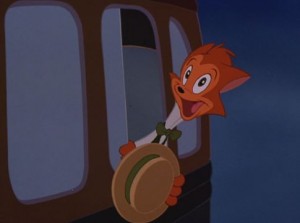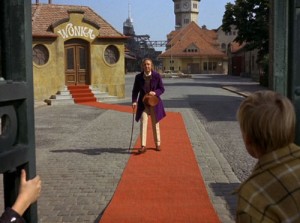Archive for category Music
CHILDHOOD REVISITED – CATS DON’T DANCE
Posted by kjohnson1585 in Animation, Childhood Revisited, Film, Music, Uncategorized, Writing on August 31, 2010
Cats Don’t Dance – 1997
Director: Mark Dindal
Starring: Scott Bakula, Jasmine Guy, Natalie Cole
Screenplay by: Mark Dindal, Robert Lence, Roberts Gannaway, Cliff Ruby, others
The Netflix blurb described Cats Don’t Dance as a “nostalgic animated version of classic MGM musicals.” That got me pretty stoked. As a youngin’, I had failed to make that connection since, while I was aware of the existence of musicals, I didn’t quite grasp their impact and significance in the overall development of American cinema and stardom. Also, watching a non-Disney animated film is always a treat, since you get to experience different themes, ideas, and movements. And, let’s be honest: Disney wouldn’t have released a film like this with such a lame title. Cats Don’t Dance? Really? The furry version of White Men Can’t Jump? Not exactly the warmest sounding title around.
NOSTALGIC LENS: I remember going to see this film by myself. It looked like a fun and eccentric romp through some crazy sets, and it was. Just TOO eccentric. Everything was going so fast and moving in blurs, harsh cuts, and speedy camera tricks that I had no idea what was going on. I remember none of the songs or secondary characters, save for the big-ass butler and really, really stupid ending sequence that actually irritated me, even in terms of cartoon logic. I’ll save that complaint – if it still holds – for the write-up.
DOES IT HOLD UP: I’ll say this: Cats Don’t Dance was not intended for the big screen. It’s a film tailor-made for the small screen – for closer observation. How often do you hear that?
Cats was marketed as a simplistic kids film of colors and frantic movement, talking animals and an Animaniacs-like exaggeration of animation, which simply put, means it’ll keep kids quiet for an hour. The movie, however, is a brightly-rainbow’d homage to not only the MGM classic musical, but the original musical nature of the early black & white/Merrie Melodies era of sing-songy cartoons. It’s a historical piece – a pretty goddamn esoteric one, but the signs are all over the celluloid.
Of course, young kids wouldn’t get it. Of course, parents wouldn’t understand what the film was delineating. The only people that may have been aware of the film’s aesthetic ties may have been historical animation fans, but that requires a clear and free understanding and appreciation of the history of American animation (and film) of a specific time period of a specific genre. That’s a rather egregious disconnect. In that way, Cats Don’t Dance is a failure, since it does little to draw its audience in and clarify its intent.
However, if you ARE aware of all of this, Cats Don’t Dance is a fresh, glorious treat of frantic action, a ballsy film against the slow, straight-forwardness of Disney or Pixar films. It’s tale – homely cat Danny travels to Hollywood to make it as a big time dancer and singer – is so typically cliche of one-third of the plot of most musicals, but that’s the point. Its entertainment draws from the energy of songs that break out of no where, of speedy dance numbers that develop into visual pastiches of its medium, of physical gags no longer utilized save in Spongebob. Check out the first ten minutes:
The simplicity of the opening montage segues into a much more exciting music piece. It’s like we’re going backwards; “Now Our Time Has Come” is such a 90s “hope song,” but “Danny’s Intro” is a play to exploring that new Hollywood space, a Wizard of Oz-like ballad of early triumph. Hello, 50s.
As I mentioned, Cats Don’t Dance homages the animated musical shorts as well. Remember when animated figures would grab random objects in a junkyard or alley and make awesome impromptu music?
I can’t help but think about this notorious cartoon when thinking about this film:
(You may have heard this on a certain South Park episode. Also – my man Tex directed this classic.)
The movie is filled with moments like this, as well as surprisingly sharp jokes about the time period. Sure, some are groaners (Rats being offended by the line “I smell a rat”), but there are some nifty ones, like when antagonist Darla Dimple (an evil Shirley Temple clone) only bites off the heads of animal crackers in front of Danny. (Darla’s offer, though, excites him so much that he starts eating the crackers too. In fact, the entire sequence between Danny and Darla is a lot of fun.)
Which is why the ending disappoints. Musicals, in general, seem to have weak, “JUST WRAP IT UP” type finales that’s all style and no substance. Whether Cats Don’t Dance played to that or not still doesn’t make it any better. Danny’s fight with big brute Max is exciting (and a marvel in animated form), but the ending sequence does nothing to build on that. Darla flicks a number of switches to try and ruin Danny and company’s final number, but it just makes it more awesome. It lacks the pluckiness of Danny’s earlier battle; none of the characters ‘fight’ through the chaos to deliver a great piece. Everything just works out. Ho-hum.
But for one hour, Cats Don’t Dance is a loose, whimsical, enjoyable film, a song/dance “cartoon-cartoon,” and not simply an animated live-action film. (The last animated film to employ such a free-sense of itself? The Emperor’s New Groove.) And it’s surprisingly relevant. Darla essentially screws Danny over; sure, Danny uses his skills and abilities to bounce back and win in the end, but he too had to do some sneaky shit to even earn that right (break into the theater of Darla’s movie premiere.) As much as we’d like to think that our abilities should speak for themselves, unfortunately in this job market, we may have to get a bit dirty before starting the cleansing process.
IN A NUTSHELL: I found myself really drawn to this film, so much so that I wanted to watch it a second time almost immediately. Sure, it’s flawed, but it’s a movie that’s one of its kind; a film that aims to be more aesthetically informative and historically nostalgic. Does it work 100%? No. But it does make you pine for the days where you can sing-a, along with the moon-a and the June-a, and the spring-a. While avoiding an anvil or six.
EDIT: I should have mentioned that Gene Kelly himself worked as a consultant on the film before he past away, which clearly contributes to the show’s wonderful energy and dance numbers.
NEXT UP: Homeward Bound: The Incredible Journey
CHILDHOOD REVISITED – WILLY WONKA AND THE CHOCOLATE FACTORY
Posted by kjohnson1585 in Childhood Revisited, Film, Music, Uncategorized, Writing on June 4, 2010
Willy Wonka and the Chocolate Factory – (1971)
Director: Mel Stuart
Starring: Gene Wilder, Jack Alberston, Peter Ostrum
Screenplay by: Roald Dahl, David Seltzer
(I apologize for the delays with the Childhood Revisited saga. It’s been a tough couple of months, and as I started working on 2 side projects, as well as providing the occasional write-up for Destructoid [along with the day job], which left me struggling to do weekly writeups. So while I won’t be getting back into the weekly C.R. reviews, I’ll try and provide one or two every month. No promises, as I also like to write about other things. :) )
I had the recent pleasure of watching The Fantastic Mr. Fox, which was a lot more fun than I expected. And with my recent foray into all things animated, light, whimsical and fun, I thought it would be fitting to try re-watching Willy Wonka. (I wonder if I should review James and the Giant Peach at some point.) It was supposed to be a Valentine’s Day write-up, then an Easter one, but I missed all those dates, so now it’s simply a regular one. I’m a bit rusty with my analysis of these things, so forgive me if it seems a bit “off.”
NOSTALGIC LENS: Every so often, there’s a not-so-subtle push to rear kids via their (supposedly) most-loved passion: candy. This and books like The Chocolate Touch used thinly-veiled metaphors to teach lessons through the delight and, uh, power of confectionery. I liked candy, but didn’t LOVE it, so I pretty much tossed aside the lessons as pointless to me. As for the movie itself, I remembered bits and pieces, but nothing that stood out, save for the chocolate river scene. Oddly enough, the part that freaks people out the most – the psychedelic boat ride – was completely gone from my memory.
DOES IT HOLD UP: I love the 70s completely unironically – from its overall sense of fashion and style, to its endearing exuberance to its cheesy TV shows, lame game show concept, overwrought music, and “whatever” dance styles in vogue (the commitment to these entertainment styles is what makes them stand out). 70s films were, overall, of two types: deep in a bizarre sense, and comical in an ironic, detached sense. One of the reasons Star Wars stood out was that its blockbuster sensibilities was so novel and straightforward and played everything real.
Willy Wonka makes great use of the latter aesthetic, being such a whimsical, devil-may-care type of film. I’ve never read the original novel, but even I can gather how much it deviated from it. (Apparently Dahl hated it.) It’s a musical, yes, but even through its melodies and comedy, the film just breaks from its original narrative not only for song cues, but for random gags attributed to a specific point in the story. It’s two insane stories in one: a international assault-search for golden tickets in Wonka bars, and a tour of Wonka’s eccentric factory with goofy yet semi-dark consequences, and during each section, we’re treated to almost variety-show-like moments that seem to take in the full extent of filmic styles of the time. The separate beats seem off but are remarkably held together by a strong and coherent style, a fun cast, and a catchy batch of tunes.
This ten minute clip is the perfect epitome to showcase what I mean. The slightly awkward “child in the chocolate” part is undermined by goofy faces and Wonka’s witticisms – which is then undermined again when he is sucked up the tube into god-knows-where. Scary? Not for long – a goofy whistle and a Oompah Loompah song calms the nerves and teaches you a quiet lesson, kiddies. That’s fine. And then it’s a boat ride into a drug-fueled TUNNEL OF HORROR, because why not?
Then it’s back to the fun stuff.
Willy Wonka is a huge risk of a film, because there’s no reason for anything to happen the way it does. There no need for the music numbers, or the side jokes, or the abject weird tunnel scene or any number of visual elements; nor is Wonka supposed to be a laureate of classic literature and poetry. But it’s there. And if there’s one thing that the internet has taught me, it’s that if you’re going to do something for no reason, you might as well do it amazingly, like if you were to, oh, let’s say, do a live-action version of the song “After Today” from A Goofy Movie.
Of course, not all of it is random, and I’m happy to say that the parts that do matter are just as great as the parts that don’t. Gene Wilder is a great Wonka, that perfect mystery of a character who’s both carefree and careless, who carries the film during ever dark and light moment with nary a concern in the world. All the children were surprisingly great, even being mostly one note, although I will give special mention to Veruca Salt, played by Julie Dawn Cole, for being such a great spoiled brat and really owning the character. The set design and cinematography is exquisite, the gags still hold up, and the music is exceedingly endearing: tell me you don’t want to sing along to “Pure Imagination”:
Still, its dated aesthetic is still apparent, and as I mentioned earlier, certain gags come off a bit stilted and awkward. (And that ending is so tacked on and rushed that it’s really disappointing). But overall, its enjoyable and, unlike other musicals, the songs aren’t way too long.
IN A NUTSHELL: Want makes this movie truly work is that, despite its visual datedness, it’s still really a delight and would definitely hold up for children today (which I couldn’t quite say for something like The Goonies or Wizard of Oz.) It’s emphasis on kids and their behavior, against the backdrop of sugary goodness (which will NEVER grow old) makes Willy Wonka a particularly, yet truly, timeless classic.
NEXT FILM: Cats Don’t Dance
BLACK MAN RAGE – “WHAT DA PROBLEM IS?” #1
Posted by kjohnson1585 in Music, Television, Uncategorized on September 18, 2009
[Ed. note: new feature where I bitch about something something.]
Oh, Ye, you incorrigible gay fish.
The innocuous event that even shut-in hermits with no access to fresh water have heard about is exploding all over the news and internet. Kanye felt it absolutely necessary to let the world know that Beyonce’s video was “totes” better than Swift’s video, which was so brave and courageous (He did it on stage! In front of tweens! You know how hard they are to please! Especially without Auto-tune!) that it earned him the Prestigious Presidential award of “Jackass of the Generation of this Decade.”
Of course, as the title of the feature suggests, I’m here to tell you the REAL reason people are raging, gossiping, and talking about this more than, let’s say, health care-something-or-other. It’s not about the interruption, the public perception of out-of-control celebrity rage, or Kanye’s batshit-insanity (look at his fucking hair! Clearly, the guy needs psychiatric help). No, dear readers. I’ll tell you what this is about.
No one knows what the hell West was talking about.
The tirade comes during a bizarre celebration of some sort of archaic nonsense so irrelevant that even its mere presence is kind of a scientific anomaly (but by no means proof of God’s existence; it somehow even discredits it). I’m not even sure what those colored, interlaced lines represent in that exact sequence. MTV’S VMA Awards? What’s an MTV? What the hell are VMAs? What do MTV and VMAs have to do with each other? And we’re awarding this? Can I get one?
And during this hodgepodge of teenage delight (not of the pre-marital kind! That’s for our vampire frienemies), as Taylor Swift received her statuette (for, I assume, having a last name that’s synonymous with “quick” or “David the Gnome’s getaway animal”), Ye proceeds to hop on stage and sprout a series of words that, while individually make sense, collectively sound like the insane ramblings of a Vietnam vet who really didn’t go to Vietnam but just has schizophrenia and pines for a magical, bizarre world of these, I assume, psychotic visions of hallucinations referred to as “music videos”. Buh? THIS IS CRAZY TALK.
Kanye might as well have interrupted the TEEN TALK TBH AWARD show, where TBH stands for absolutely nothing that anyone actually knows or particularly cares about, and screamed “I’m gonna let ya finish yo’ thing, but that sperm waster chick over there has one of the hottest widgets this side of Pleasantville.” Utter nonsense. We’re still trying to figure out WHAT IT ALL MEANS in the greater sense of things. Beyonce’s video? You mean one of her home videos? Did she release a porn video? Is video some feminist term meaning “aura”?
But, fuck it. Let’s swallow the Adderall and pretend for a second we all know what a VMA is and spent the man-hours watching them. Which one would indeed be the better one? Well, I’ll be the decider here, and ultimately determine which video is indeed the “hottest”.
Taylor Swift – “You Belong to Me”
Oh, nerd girl, you’ll never get the guy unless you take off your glasses. Nothing kills a boner faster than eyewear. I can imagine that conversation.
Guy: Hey, baby, how abut we—“OH GOD WHAT IS THAT ON YOUR FACE, A DEADLY SPIDER?”
Girl: They’re my glasses.
Guy: *PUKES*
That, by the way, takes place over window-tag via shapies and notebooks. Instant messenger just lacks the “shitty handwriting” authenticity and love. And PHONE CALLS? FUCK THAT.
As for the song? Meh. I probably could play that guitar rift, and I don’t know the difference between a guitar and a latte. (I will give props to the fact that the music actually relates to the video. I’ve never seen that happen before, ever.)
Beyonce – “Single Ladies (Put a Ring on it)”
Ooh, yeah! 90s dance routines with 2000 editing techniques! It’s as if the intro to In Living Color was in black and white (the goddamn irony!) and shot by the Saw director(s). And what shitty, shitty choreography. Usher, show her how it’s done, please.
….
What, you played out, too? Damn.
As for the song? Meh. I guess the single ladies like it. Was this the song Stephanine Meyer was listening too before she envisioned celibate vampires? No, it was Muse, but I’d like to think she’s all about interracial musical tastes.
So, which music video is the better of the two? The answer may surprise you.
This was, is, and will be the best music video ever made, ever.



